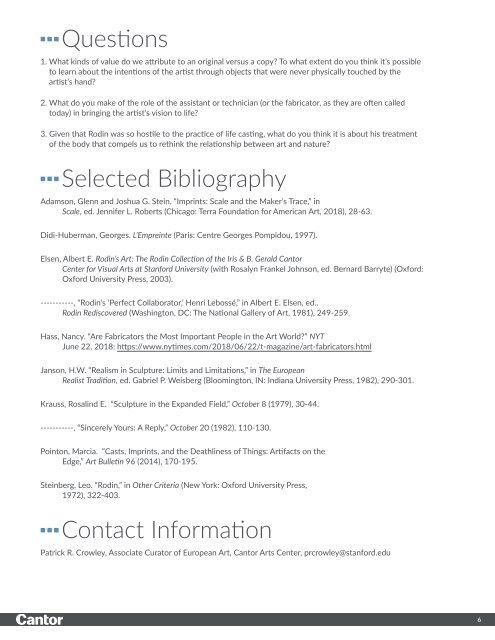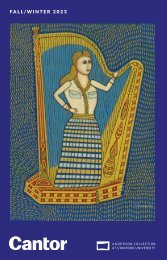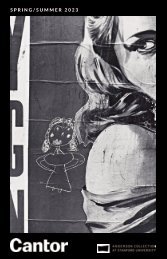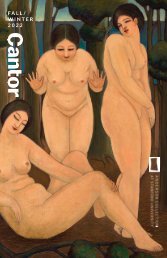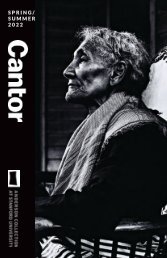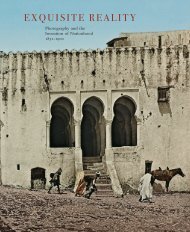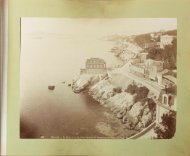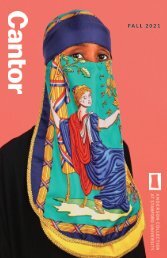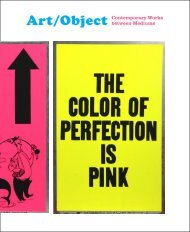Learning Guide | Recasting Rodin
It would hardly be an exaggeration to say that Auguste Rodin (1840–1917) forever changed the history of sculpture. Rarely had the medium so audaciously challenged the primacy of painting over the course of the nineteenth century. Long regarded as a “dead” medium of motionless, inert material, sculpture in Rodin’s nimble hands comes alive, breaking free of the plinths that traditionally separated sculpted figures in stone or metal from their earthbound beholders in flesh and blood. Patrick R. Crowley, PhD Associate Curator, European Art Cantor Arts Center
It would hardly be an exaggeration to say that Auguste Rodin (1840–1917) forever changed the history of sculpture. Rarely had the medium so audaciously challenged the primacy of painting over the course of the nineteenth century. Long regarded as a “dead” medium of motionless, inert material, sculpture in Rodin’s nimble hands comes alive, breaking free of the plinths that traditionally separated sculpted figures in stone or metal from their earthbound beholders in flesh and blood.
Patrick R. Crowley, PhD
Associate Curator, European Art
Cantor Arts Center
You also want an ePaper? Increase the reach of your titles
YUMPU automatically turns print PDFs into web optimized ePapers that Google loves.
■ ■ ■Questions<br />
1. What kinds of value do we attribute to an original versus a copy? To what extent do you think it’s possible<br />
to learn about the intentions of the artist through objects that were never physically touched by the<br />
artist’s hand?<br />
2. What do you make of the role of the assistant or technician (or the fabricator, as they are often called<br />
today) in bringing the artist’s vision to life?<br />
3. Given that <strong>Rodin</strong> was so hostile to the practice of life casting, what do you think it is about his treatment<br />
of the body that compels us to rethink the relationship between art and nature?<br />
■ ■ ■Selected Bibliography<br />
Adamson, Glenn and Joshua G. Stein. “Imprints: Scale and the Maker’s Trace,” in<br />
Scale, ed. Jennifer L. Roberts (Chicago: Terra Foundation for American Art, 2018), 28-63.<br />
Didi-Huberman, Georges. L’Empreinte (Paris: Centre Georges Pompidou, 1997).<br />
Elsen, Albert E. <strong>Rodin</strong>’s Art: The <strong>Rodin</strong> Collection of the Iris & B. Gerald Cantor<br />
Center for Visual Arts at Stanford University (with Rosalyn Frankel Johnson, ed. Bernard Barryte) (Oxford:<br />
Oxford University Press, 2003).<br />
-----------, “<strong>Rodin</strong>’s ‘Perfect Collaborator,’ Henri Lebossé,” in Albert E. Elsen, ed.,<br />
<strong>Rodin</strong> Rediscovered (Washington, DC: The National Gallery of Art, 1981), 249-259.<br />
Hass, Nancy. “Are Fabricators the Most Important People in the Art World?” NYT<br />
June 22, 2018: https://www.nytimes.com/2018/06/22/t-magazine/art-fabricators.html<br />
Janson, H.W. “Realism in Sculpture: Limits and Limitations,” in The European<br />
Realist Tradition, ed. Gabriel P. Weisberg (Bloomington, IN: Indiana University Press, 1982), 290-301.<br />
Krauss, Rosalind E. “Sculpture in the Expanded Field,” October 8 (1979), 30-44.<br />
-----------, “Sincerely Yours: A Reply,” October 20 (1982), 110-130.<br />
Pointon, Marcia. “Casts, Imprints, and the Deathliness of Things: Artifacts on the<br />
Edge,” Art Bulletin 96 (2014), 170-195.<br />
Steinberg, Leo. “<strong>Rodin</strong>,” in Other Criteria (New York: Oxford University Press,<br />
1972), 322-403.<br />
■ ■ ■Contact Information<br />
Patrick R. Crowley, Associate Curator of European Art, Cantor Arts Center, prcrowley@stanford.edu<br />
6


